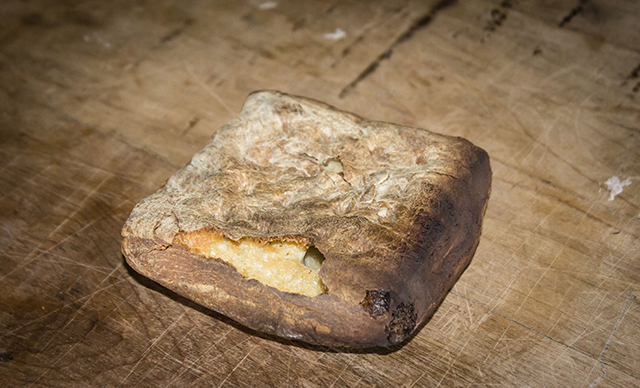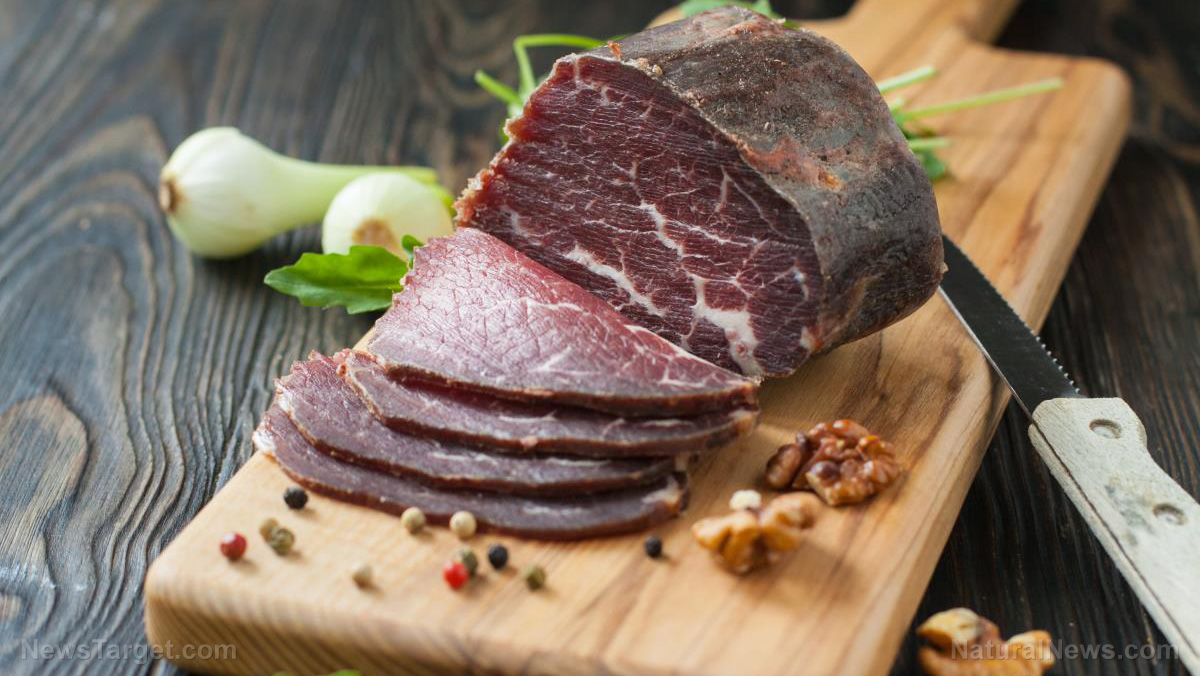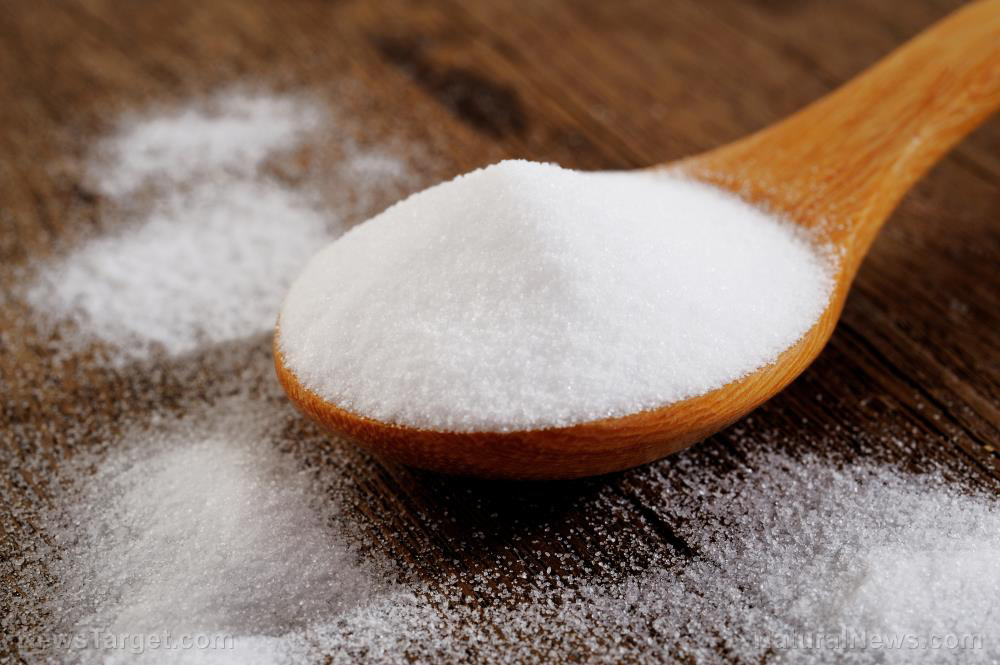
Hardtack
Also called hard bread, this tough biscuit is a survival food with a history going back as far as Ancient Rome.
Ingredients:
- 5 cups wheat flour
- 2 quarts water
- 3 teaspoons of salt
Combine all of these ingredients in a large mixing bowl. When the flour, salt and water have formed a dry bread dough, roll it out flat with a rolling pin or pat it out by hand. If the dough still has sticky spots, add more flour.
Make a 12-inch-thick dough sheet, cut it into three-inch squares and poke holes in both sides of each dough square. Bake these squares for 30 minutes per side at 375 F on an ungreased cookie sheet.
Keep your hardtack in a cool, dry and dark place away from pests. Once hardtack has fully dried, it can last for years if stored properly.
Pemmican
Pemmican is a very ancient forerunner to modern survival rations, known as a very weird meatball made of dried meat and rendered fat. It is filled to the brim with calories and its invention its popularity is traditionally credited to Native Americans.
Ingredients:
- 8 ounces of lard
- 8 ounces of packed powdered jerky chopped in a blender
- 8 ounces of dried fruit, ideally berries
Warm the lard in a pot to a temperature below 100 F until it turns into a soft, pasty texture. Keep stirring while it heats up. Stir your other ingredients into the softened fat until they have thoroughly combined with the lard, which usually takes about two minutes of continuous stirring.
Human knowledge is under attack! Governments and powerful corporations are using censorship to wipe out humanity's knowledge base about nutrition, herbs, self-reliance, natural immunity, food production, preparedness and much more. We are preserving human knowledge using AI technology while building the infrastructure of human freedom. Speak freely without censorship at the new decentralized, blockchain-power Brighteon.io. Explore our free, downloadable generative AI tools at Brighteon.AI. Support our efforts to build the infrastructure of human freedom by shopping at HealthRangerStore.com, featuring lab-tested, certified organic, non-GMO foods and nutritional solutions.
If you have the ingredients, feel free to add small amounts of flour or other starch sources for additional carbohydrates. You can even add different spices to add some flavor.
Turn off the heat and, once the mixture is cool enough to touch, scoop it out by hand and compress it into round balls or flat cakes. Be sure to let the pemmican completely cook before you store it.
Traditionally, pemmican would usually be stored in rawhide containers. Instead of this, you can wrap up the pemmican in wax paper and keep it stored in a cool place. If kept relatively cool, pemmican can last for months. However, as the weather warms, it would be wise to eat the pemmican before the fat begins to smell rancid.
Bannock
Sometimes called skillet bread, bannock is a round, flat, unleavened bread that is associated with Scotland and northern England. Although you can adapt a bannock recipe for the oven, it is meant to be cooked in a skillet over a campfire or in a fireplace.
Ingredients:
- 4 cups all-purpose flour
- ½ teaspoon salt
- ½ teaspoon baking soda
- 1 tablespoon sugar
- 1 ¾ cups dried fruit (e.g., cherries)
- 1 teaspoon chopped rosemary
- 1 ½ cups buttermilk or sour milk
Preheat your oven to 300 F.
In a medium-sized bowl, combine all of your dry ingredients except for the dried fruit and rosemary. Thoroughly mix them. Chop your dried fruit and rosemary into very fine pieces and set aside.
Now that you have a bowl full of dry ingredients, make a well in the center for your buttermilk. Add the buttermilk to the well and begin to slowly incorporate flour from the sides – this will allow you to control the dough consistency. Do not collapse the sides of the well. You will have leftover flour to coat your table and to use while you knead the dough.
Once the batter becomes stodgy and pasty, you can add your finely chopped dried fruit and rosemary. At this point, you are going to dump the dough out onto a floured surface. Work the dough and add flour until it becomes less sticky and the dried fruit and rosemary are fully incorporated.
At this point, you are ready to begin baking the bannock. Bake the bannock for 20 minutes until it has started to brown a bit. Remove the bannock and allow it to rest and cool. After the bannock has completely cooled, it can be sliced and served or sliced and stored.
The best storage method is to keep it whole until you need it. If you leave it uncovered, it will get very hard in a couple of days. Freezing would be the best way to keep it for a really long time. But if you don’t have that option, keep it hard and dry. (Related: 8 survival bread recipes for preppers.)
Biltong
Biltong is a traditional South African food that consists of dried and marinated meat. Whereas jerky is often smoked, biltong is cured with vinegar, salt and spices and then air-dried. Also, you can make biltong from a large variety of meat cuts.
Ingredients:
- 2 kilograms (4.4 pounds) of lean meat
- 2 cups brown sugar
- 3 cups plump sea salt
- 1 teaspoon baking soda
- 2 tablespoons ground black peppercorns
- 100 ml Worcestershire sauce
- 5 cups vinegar
- 4 tablespoons of ground coriander seeds
To prepare the meat, always cut to the length of the grain, never against it. Prepare 1 cm thick slices of meat and then put those slices into the vinegar-Worcestershire sauce mix for half an hour. Store the remaining vinegar in the fridge because it will be used later in the recipe.
Crush all the spices and then mix in the salt, baking soda and sugar. Make sure that all the meat is perfectly coated with this and then layer those slices on a clean plate. Place the thickest slice at the base and the other chucks above it. Sprinkle your remaining spice mixture on top of the upper layer. Refrigerate for at least eight hours.
Take out the refrigerated chunks of meat and then soak them again in the vinegar mix for at least 15 minutes. Remove the meat slices and then rinse out the salt residue from every piece. Squeeze the moisture out of the meat pieces.
You can then dry the biltong in two different ways in the oven or in the traditional way by hanging the strips up on racks in a room with good circulation. Alternatively, the strips can be refrigerated and, if frozen, they can last for up to a year.
Trail biscuit
This is a stick-to-your-ribs food that will help stretch rations or fill bellies. The egg and lard are optional, but if you’re not using lard, substitute the baking powder for a couple of teaspoons of baking soda.
Ingredients:
- 3 ½ cups all-purpose flour
- 2 tablespoons baking powder
- 1 egg (optional, if available)
- 1 teaspoon salt
- ½ cup lard (or butter)
- 1 ½ cups milk
Preheat oven to 370 F or stoke your coals so they’re hot enough to cook on.
Combine flour, salt and baking powder (or baking soda) in a bowl, then cut the cold lard (or butter) into the flour mixture until you have pea-sized pieces. Add milk until the dough is barely sticky. Don’t overmix or your biscuits will be tough.
Drop about ¼ cup of the batter into a greased pan or Dutch oven. Cook for 20 minutes or so until the biscuits are brown. If using a Dutch oven, put the biscuits in.
There are many, many more survival foods you can make to keep you well-fed with necessary nutrients during survival situations, such as parched corn, trench cake, jerky, dried fruit, beans and rice and peasant's bread. What's important is you are aware of the kinds of foods you can make that can keep you sustained during emergencies.
Watch the following video to learn how to make survival chocolate.
This video is from the Cahlen channel on Brighteon.com.
More related stories:
Prepper recipes: How to make pinole, a tasty survival superfood.
How to make matzoh, a survival food from biblical times.
How to make hominy, an ancient survival food.
Sources include:
Please contact us for more information.



















